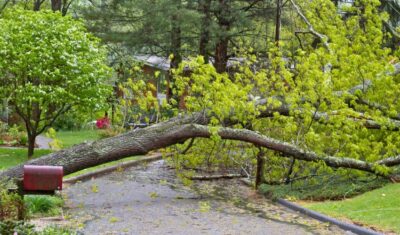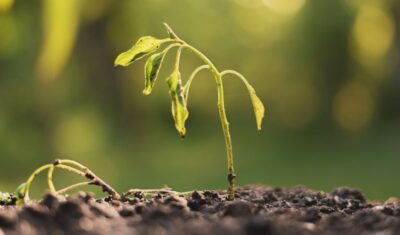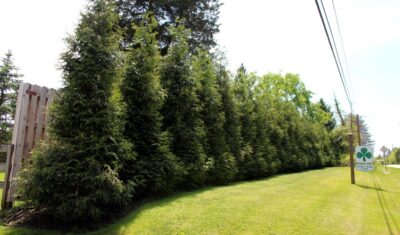Aphids are insect pests that feed on many tree and plant species in Northeastern Ohio.
Effective aphid control starts with identifying the pests and recognizing the damage they cause.
Once correctly identified, there are several methods you can employ to battle the aphid populations attacking your trees and plants.
What are Aphids?
Aphids are a large group of insects of the superfamily Aphidoidea. There are over 1,300 species of Aphids in the United States though only a handful are considered pests. However, pest aphids are a common problem in Northeastern Ohio that can injure your plants and trees, even killing them if infestations are severe enough.
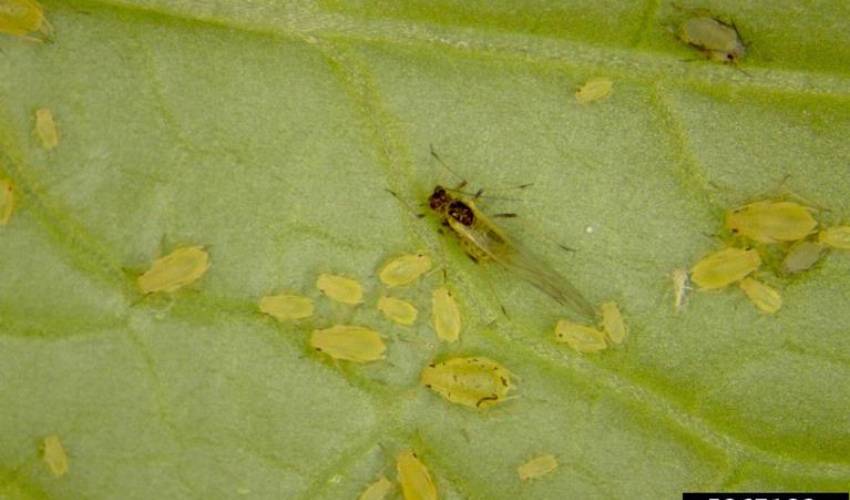
Aphid nymphs and a winged adult feeding on the underside of a leaf. Image used courtesy of Whitney Cranshaw, Colorado State University, Bugwood.org.
Identifying Aphids
Also known as “plant lice” or “ant cows,” aphids come in various colors, including light green, brown, black, purple, or red. Aphids are 1/16 to 1/8 inch long and show up in large numbers on the leaves and stems of your trees and plants.
Aphids can be identified by their thin legs, long antennae, and pear-shaped bodies. These tiny but voracious pests use their piercing mouth parts to suck out the juices inside plant tissues. Some aphid species are even known to feed on plant roots.
Understanding Aphid Reproduction
Aphid reproduction differs depending on the species. Some reproduce asexually, some alternate between sexual and asexual reproduction, and others complicate the strategy further by using multiple host plants to complete their reproductive cycle.
Asexually Reproducing Aphids
The simplest form of aphid reproduction is asexual. In this case, females give birth to live female nymphs that immediately start feeding on their host plants. These “clones” shed their skins several times to complete their development, all the while sucking the life out of the trees and shrubs they feed on.
As the colony gets larger, winged forms of aphids develop that move on to colonize other plants. The lifecycle of these asexual aphids is completed in 10-14 days.
Sexually Reproducing Aphids
A second group of aphids alternates between asexual and sexual reproduction depending on the time of year. Through the spring and summer, the exclusively female population asexually reproduces only more females for the first part of the year.
When fall approaches, the females start producing males and females who reproduce sexually, with the females laying eggs that will overwinter on the host plants. Come spring, the eggs hatch and the cycle of asexual to sexual reproduction begins again.
Sexual Reproduction Using Multiple Host Plants
The third aphid reproductive strategy is more complicated and involves alternating between asexual and sexual reproduction and switching plant hosts. This strategy begins with the asexual reproduction of female aphids, like the previous strategies.
However, winged aphids fly in late summer to find new plants. These flying aphids lay their eggs on the new host plant. The eggs then hatch as sexually reproducing males and females. After mating, the females return to their original host plant to lay their eggs. The eggs overwinter on the plant until they hatch in the spring, beginning the cycle again.
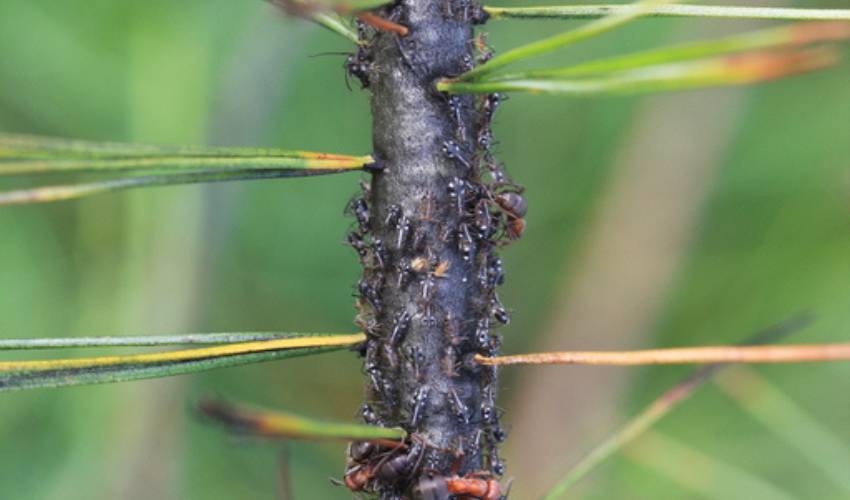
Black sooty mold is a common sign of aphid infestations. It grows on the sweat, sticky honeydew excreted by aphids as they feed on plants.
Recognizing the Signs of an Aphid Infestation
Honeydew, Ants, & Sooty Mold
As they feed on your plants, aphids secrete a sticky golden liquid called honeydew. This sweet substance attracts ants, flies, and other insects seeking a meal, becoming pests themselves.
The honeydew soon becomes covered in sooty mold, a generally benign black fungus. Though harmless, sooty mold reduces the natural beauty of your plants. Fortunately, sooty mold goes away on its own, but not until the aphid infestation is controlled.
How to Get Rid of Aphids
Several methods can be used to control aphids depending on the size of the infestation and the level of intervention required.
Using Plants to Deter Aphids
There are several plants and herbs you can incorporate in your landscape to repel aphids. These include:
- Garlic
- Chives
- Leeks
- Fennel
- Dill
- Cilantro
- Catnip
- Marigolds
These plants deter aphids due to their scent. There are also several “trap plants” that have been shown to effectively control aphids. These plants work by drawing aphids to them, localizing populations for easier control.
Removing Aphids with a Hose
You can spray your plants gently with the stream from your garden hose for minor infestations. The water will wash the aphids away, and since aphids can’t climb, they won’t be able to return to the host plant. Spraying with water should be done periodically to control new infestations.
Killing Aphids with Soapy Water
Spraying aphids with a soapy water solution will kill them. This method works by clogging up the aphids’ spiracles, the breathing holes that line the sides of their abdomens, suffocating them. When preparing your soapy water, use approximately 4-5 tablespoons for each gallon of water.
Using “Soft” Insecticides
Aphids are soft-bodied pests, so spraying them with horticultural oils often works well for controlling infestations. These controls require contact with the insect, so thorough coverage of the infested plants is essential.
Remember, though these oils are often natural and organic, it’s still important to consult a fact sheet to ensure they’re safe for your plants and to determine appropriate application rates and timing.
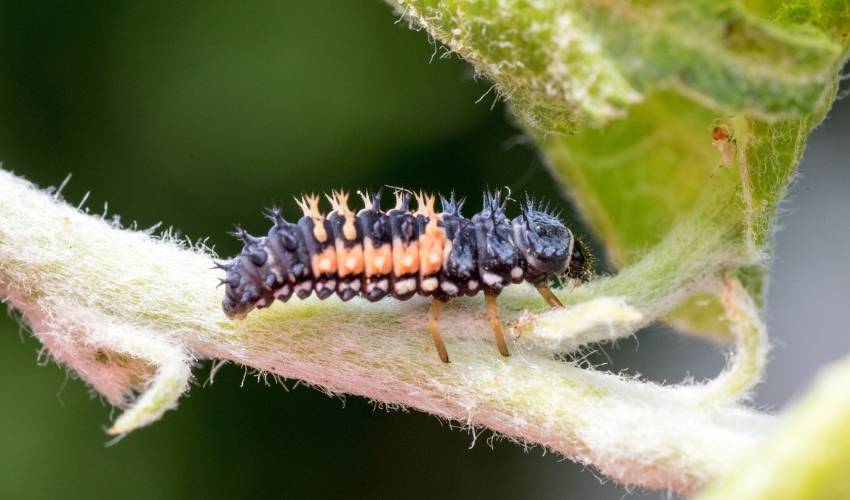
Larvae have an alligator-like appearance, and are black with orange markings. Don’t mistake them for a pest! They’re one of the best aphid-control options for Northeast Ohio landscapes.
Let Nature Do It for You
In a healthy, organic landscape with a variety of plants, shrubs, and trees, aphid outbreaks are often controlled by beneficial insects. For example, the ladybug is an insatiable predator of aphids, consuming several hundred per day! Even the larva (immature stage of the lady beetle) will eat 200-300 as it grows. A variety of bugs (such as damsel bugs and minute pirate bugs), beetles (such as the soldier beetle), flies, parasitic wasps and lacewings also feed on aphids.
Chemical Control of Aphids
Chemical pesticide treatments should only be employed for extreme infestation levels since they will often impact non-targeted insect species. It should also be mentioned that many pesticides require very specific mixing and application which should be left to professionals.
Contact Pesticides for Aphid Control
Contact pesticides kill aphids directly through direct contact, disrupting biological functions. These contact pesticides are common in agriculture and greenhouse operations, and aphids develop resistance because of repeated exposure. To combat this resistance, different chemical pesticides should be rotated so the populations can’t “get used to” a single chemical.
Systemic Pesticides for Aphid Control
Systemic pesticides work differently than contact pesticides. These are chemicals taken up by the plant tissues, killing the pest when it feeds. These pesticides are usually applied to the soil at the base of the plant as either a spray, drench, or granules.
The advantage of these systemic pesticides is that since they don’t irritate the aphids, they don’t encourage populations to drift to other locations. Additionally, these systemic treatments are typically effective throughout the year.
Remember, no matter what pesticide is used, care and caution should be taken to avoid improper use. Consult with an expert before attempting to apply pesticides on your own. Many pesticides require specific application techniques that the average homeowner is not equipped to do.
The best way to stay on top of aphids is to monitor your plants for signs of infestation, treat them early, and continue to monitor and inspect them throughout the year to stay on top of them.
What’s the Best Time of Year to Treat for Aphids?
Aphids are most active in the spring, which makes the season an ideal time for treatment, though the pests can be treated in the summer too.
Early spring treatment is effective as the aphids multiply, while many other insects you don’t want to kill aren’t as active. Systemic treatments should also be applied early in the season since some take up to two weeks to be incorporated into plant tissues and become effective.
Independent Tree Can Help with Aphid Control!
Aphids are a common issue for trees and plants in Northeast Ohio, but they aren’t the only pest that trees and plants in our area have to deal with.
Fortunately, Independent Tree has the skills, equipment, and treatment options to help keep your trees and plants healthy no matter the issue.
Our Certified Arborists can inspect your trees to diagnose the specific pest infesting them, evaluate the severity of the infestation, and suggest treatment options to control the pest population and minimize damage.
Whether you suspect an aphid infestation or are concerned that your trees aren’t as healthy as they should be, call us at 440-367-8756 to schedule an arborist assessment.
Worried about your trees’ health?
Regular maintenance and preventive plant health care are excellent ways to prevent or treat tree pests, such as aphids, and disease issues.Recent Articles
Topics
About The Author

STAY IN THE LOOP
WITH OUR
LATEST UPDATES
"*" indicates required fields

